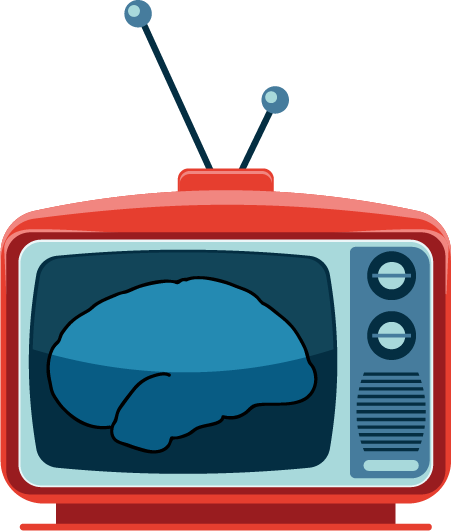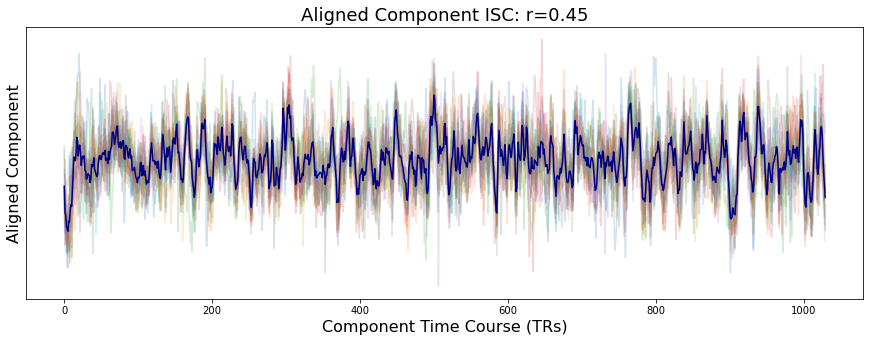Functional Alignment¶
Written by Luke Chang
One of the main goals of cognitive neuroscience is to understand how the brain represents and processes information about the external world, integrates it with internal goals and previous experiences, and produces actions. An implicit assumption in almost all neuroimaging studies is that each person’s brain processes information in the same way as other people’s brains. In neuroimaging research we have acknowledged that there is wide variation in individual neuroanatomy, and a key preprocessing step is to normalize each participant into a common stereotactic space. We also know that these algorithms are not perfect and that applying a small amount of local Gaussian smoothing can help mitigate small misalignments and increase voxel signal to noise ratios. While these techniques appear to work reasonably well when performing mass univariate testing, they may have some limitations when using multivariate techniques. For example, multivariate models such as prediction/classification and representational similarity analysis assume that the features of the model (e.g., voxels) are aligned across participants and that patterned variations within these features reflect information processing.
There has been growing interest in developing new algorithms to project subjects into a common space based on how a voxels respond to stimuli (Haxby et al., 2011 ; Guntupalli et al., 2016) or are connected to other voxels (Guntupalli, et al., 2018). These efforts have been largely lead by Jim Haxby and Peter Ramadge’s research groups over the past decade and are generally referred to as hyperalignment, or functional alignment.
The basic idea behind hyperalignment is to treat cortical patterns as vectors corresponding to locations in a high dimensional space, where each axis reflects a measurement of that pattern (e.g., voxel activity) (Haxby, 2014). Thus, rather than treating cortical functions in a 1D (average roi activity), 2D (cortical sheet), or 3D physical space, hyperalignment models information as being embedded in an n-dimensional space, where n reflects the number of measurements (e.g., voxels). Vector representations of cortical patterns can then be transformed into a common high dimensional space that is shared across participants. This idea of transforming individual cortical patterns into a common high dimensional model space can be seen in the following figure from (Haxby et al., 2020).
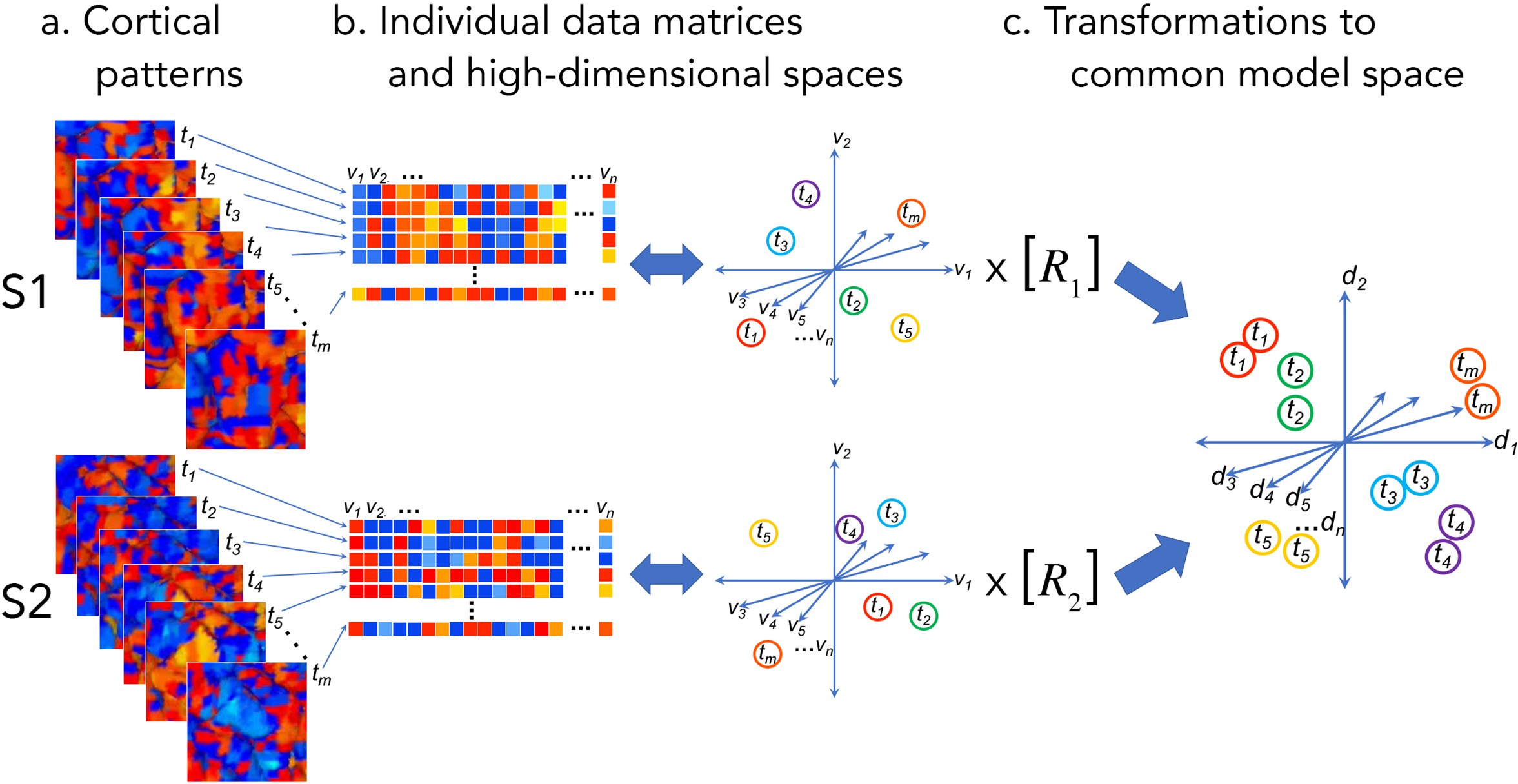
There are many different models of functional alignment. Response-based hyperalignment uses an iterative procrustes transform to scale, rotate, and reflect voxel time series so that they are in the same functional space across participants (Haxby et al., 2011 ; Guntupalli et al., 2016). Connectivity-based hyperalignment instead aligns voxels based on their embedding with other voxels using seed-based functional connectivity (Guntupalli, et al., 2018). There is also another approach called the Shared Response Model, which learns a joint-SVD and can project subjects into a lower dimensional common space (Chen et al., 2014, Chen et al., 2015). Overall, it has been shown that all of these different approaches can dramatically improve between subject classification accuracy particularly in ventral temporal cortex. In addition, lower dimensional projections removes redundant axes in the high dimensional space and can effectively denoise the signal, which also improves classification accuracy.
Hyperalignment was developed at Dartmouth College and is implemented in the PyMVPA toolbox. There is a tutorial on the PyMVPA website for how to implement different versions of hyperalignment. The Shared Response Model was developed at Princeton University and is implemented in the brainiak toolbox and I also encourage you to see their excellent tutorial.
In this tutorial, we will walk through how to perform Response-Based Hyperalignment and the Shared Response model on the Sherlock dataset using the nltools toolbox.
Before we get started, I encourage you to watch this video by Dr. James Haxby, PhD from the 2018 MIND Computational Summer School in which he discusses how hyperalignment can be used to model the shared deep structure of information encoded in fine-scale cortical topographies. This video is about an hour long and provides an excellent overview of hyperalignment.
from IPython.display import YouTubeVideo
YouTubeVideo('QX7sNaLyxdo')
Getting Started¶
Before getting started with this tutorial, we need to make sure you have the necessary software installed and data downloaded.
Software¶
This tutorial requires the following Python packages to be installed. See the Software Installation tutorial for more information.
seaborn
matplotlib
pandas
nltools
nilearn
datalad
Let’s now load the modules we will be using for this tutorial.
import os
import glob
import numpy as np
import pandas as pd
import seaborn as sns
from nltools.mask import create_sphere, expand_mask
from nltools.data import Brain_Data, Adjacency
from nltools.stats import align
import matplotlib.pyplot as plt
import matplotlib.gridspec as gridspec
from nilearn.plotting import plot_stat_map
import datalad.api as dl
import warnings
warnings.simplefilter('ignore')
Data¶
This tutorial will be using the Sherlock dataset and will require downloading the cropped & denoised .hdf5 files.
You will want to change data_dir to wherever you have installed the Sherlock datalad repository. We will initialize a datalad dataset instance and get the files we need for this tutorial. If you’ve already downloaded everything, this cell should execute quickly. See the Download Data Tutorial for more information about how to install and use datalad.
data_dir = '/Volumes/Engram/Data/Sherlock'
# If dataset hasn't been installed, clone from GIN repository
if not os.path.exists(data_dir):
dl.clone(source='https://gin.g-node.org/ljchang/Sherlock', path=data_dir)
# Initialize dataset
ds = dl.Dataset(data_dir)
# Get Cropped & Denoised HDF5 Files
result = ds.get(glob.glob(os.path.join(data_dir, 'fmriprep', '*', 'func', f'*crop*hdf5')))
Functional alignment is typically performed within an ROI. The original hyperalignment papers align within searchlights over the whole brain. We tend to align within regions of interest from whole-brain functional parcellations. We will use a n=50 parcellation based on patterns of coactivation from the Neurosynth database (de la Vega et al., 2016).
We can load data from a file or web URL using the Brain_Data data class from nltools. Each parcel is associated with a unique integer.
mask = Brain_Data('https://neurovault.org/media/images/8423/k50_2mm.nii.gz')
mask_x = expand_mask(mask)
mask.plot()

First, let’s extract data from each subject within a region of interest. In this example, we will extract voxel activity within early visual cortex from the second half of Sherlock (i.e., Part2) using the hdf5 files (~ 2min). You can also switch the glob flag from hdf5 to nii.gz, but note that loading large nifti files with nltools can be slow (~15-20min).
scan = 'Part2'
roi = 4
roi_mask = mask_x[roi]
file_list = glob.glob(os.path.join(data_dir, 'fmriprep', '*', 'func', f'*crop*{scan}*hdf5'))
all_data = []
for f in file_list:
sub = os.path.basename(f).split('_')[0]
print(sub)
data = Brain_Data(f)
all_data.append(data.apply_mask(roi_mask))
sub-01
sub-02
sub-03
sub-04
sub-05
sub-06
sub-07
sub-08
sub-09
sub-10
sub-11
sub-12
sub-13
sub-14
sub-15
sub-16
roi_mask.plot()

Hyperalignment¶
Now that the data is loaded and has been extracted within the mask, we can perform functional alignment.
We will now align voxels with the same signal across participants. We will start using hyperalignment with the procrustes transform. The align() function takes a list of Brain_Data objects (or numpy matrices) and aligns voxels based on similar responses over time. We will extract the subject specific Brain_Data instances from the dictionary and cast as a list. We will exclude the last subject for now and will add them later in the tutorial.
Functional alignment with the procrustes transformation can be a little slow. This example takes about 7-10 minutes.
hyperalign = align(all_data[:15], method='procrustes')
The align function outputs a dictionary with keys for a list of the transformed data, corresponding transformation matrices, the common model in which all subjects are projected, and Intersubject Correlations (ISC) for the transformed data. The disparity values correspond to the multivariate distance of the subject to the common space.
Plot Aligned Voxel Time course¶
Let’s pick a random voxel from early visual cortex and see how similar the activity is across participants using intersubject correlations (ISC). ISC is the average pairwise correlation between subject voxel time courses.
Feel free to pick a different voxel by changing the voxel_index variable.
voxel_index = 50
voxel_unaligned = pd.DataFrame([x.data[:, voxel_index] for x in all_data]).T
voxel_aligned = pd.DataFrame([x.data[:, voxel_index] for x in hyperalign['transformed']]).T
f, a = plt.subplots(nrows=2, figsize=(15, 5), sharex=True)
a[0].plot(voxel_unaligned, linestyle='-', alpha=.2)
a[0].plot(np.mean(voxel_unaligned, axis=1), linestyle='-', color='navy')
a[0].set_ylabel('Unaligned Voxel', fontsize=16)
a[0].yaxis.set_ticks([])
a[1].plot(voxel_aligned, linestyle='-', alpha=.2)
a[1].plot(np.mean(voxel_aligned, axis=1), linestyle='-', color='navy')
a[1].set_ylabel('Aligned Voxel', fontsize=16)
a[1].yaxis.set_ticks([])
plt.xlabel('Voxel Time Course (TRs)', fontsize=16)
a[0].set_title(f"Unaligned Voxel ISC: r={Adjacency(voxel_unaligned.corr(), matrix_type='similarity').mean():.02}", fontsize=18)
a[1].set_title(f"Aligned Voxel ISC: r={Adjacency(voxel_aligned.corr(), matrix_type='similarity').mean():.02}", fontsize=18)
Text(0.5, 1.0, 'Aligned Voxel ISC: r=0.43')
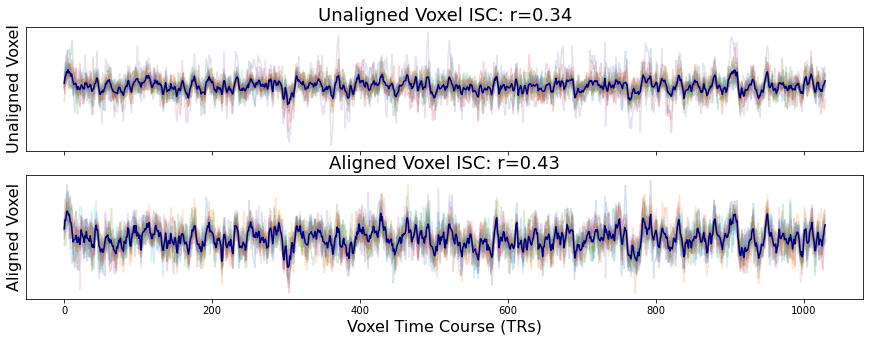
You can see that the overall time course of the both the unaligned and aligned voxel activity is very similar. However, participants have an overall higher degree of similarity after hyperalignment (r=0.47) compared to the unaligned data (r=0.36). This is true of most voxels. You can test this yourself by changing the voxel index.
We can also plot the distribution of overall ISC across all voxels.
plt.hist(hyperalign['isc'].values())
plt.axvline(x=np.mean(list(hyperalign['isc'].values())), linestyle='--', color='red', linewidth=2)
plt.ylabel('Frequency', fontsize=16)
plt.xlabel('Voxel ISC Values', fontsize=16)
plt.title('Hyperalignment ISC', fontsize=18)
print(f"Mean ISC: {np.mean(list(hyperalign['isc'].values())):.2}")
Mean ISC: 0.36

You can see that overall ISC across voxels is pretty high, mean=0.36. Remember that this value is biased because it is not cross-validated so it is likely slightly inflated.
Plot Transformed Data¶
We can also see the impact of hyperalignment on the spatial topography. We can grab any TR and see the spatial patterns of the voxel activity. Notice how the activity patterns of the aligned voxels are much more spatially similar after hyperaligment. The idea is that voxels are rearranged to maximize temporal synchrony. The hyperalignment algorithm picks a random subject and then projects every other subject into that space. This is averaged and then iteratively repeated.
tr_index = 100
f,a = plt.subplots(ncols=5, nrows=2, figsize=(15,6), sharex=True, sharey=True)
for i in range(5):
sns.heatmap(np.rot90(all_data[i][tr_index].to_nifti().dataobj[30:60, 10:28, 37]), cbar=False, cmap='RdBu_r', ax=a[0,i])
a[0,i].set_title(f'Subject: {i+1}', fontsize=18)
a[0,i].axes.get_xaxis().set_visible(False)
a[0,i].yaxis.set_ticks([])
sns.heatmap(np.rot90(hyperalign['transformed'][i][tr_index].to_nifti().dataobj[30:60, 10:28, 37]), cbar=False, cmap='RdBu_r', ax=a[1,i])
a[1,i].axes.get_xaxis().set_visible(False)
a[1,i].yaxis.set_ticks([])
a[0,0].set_ylabel('Unaligned Voxels', fontsize=16)
a[1,0].set_ylabel('Aligned Voxels', fontsize=16)
plt.tight_layout()
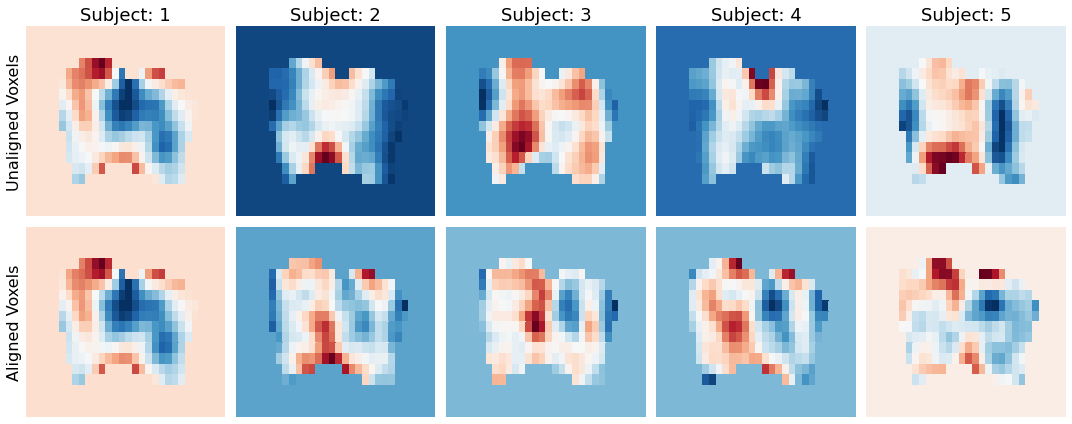
Align new subject to common model¶
We can align new subjects into the common model without retraining the entire model. Here we individually align subject 16, who was left out of the original training to the common space learned above using hyperalignment.
new_data = all_data[-1]
new_data[0].plot()

aligned_sub_hyperalignment = new_data.align(hyperalign['common_model'], method='procrustes')
aligned_sub_hyperalignment['transformed'][0].plot()

You can see that the pattern of cortical activation has now changed after projecting this subject into the common space using hyperalignment.
We can also project subject 16 into the SRM common space. Don’t forget we also need to z-score this subject’s data to be consistent with how the model was trained.
aligned_sub_srm = new_data.standardize(method='zscore').align(srm['common_model'], method='deterministic_srm')
aligned_sub_srm['transformation_matrix'][0].plot()

Cross-Validation - Project New Subject Data into Common Space¶
Because the functional alignment models were trained to maximize ISC, the ISC values are biased and will likely be inflated. As with all machine learning algorithms, it is important to evaluate how well the model works on independent data. If you have lots of data from each subject, you can a priori divide some of it into training and test. If you don’t have lots of data, you can perform cross-validation to approximate how well your model will perform on new data.
The basic idea is to use the learned subject-specific transformation matrices to project new independent data from that participant into the common space.
In this tutorial, we will project Part1 Sherlock data into common space using Part2 data.
Let’s load the Part1 data and overwrite the Part2 data to save RAM.
scan = 'Part1'
roi = 4
roi_mask = mask_x[roi]
file_list = glob.glob(os.path.join(data_dir, 'fmriprep', '*', 'func', f'*crop*{scan}*hdf5'))
all_data = []
for f in file_list:
sub = os.path.basename(f).split('_')[0]
print(sub)
data = Brain_Data(f)
all_data.append(data.apply_mask(roi_mask))
sub-01
sub-02
sub-03
sub-04
sub-05
sub-06
sub-07
sub-08
sub-09
sub-10
sub-11
sub-12
sub-13
sub-14
sub-15
sub-16
Ok, now let’s start by projecting subject 16’s Part1 data into the common space. First, we will create a copy of subject 16’s data variable. Then, we will grab the transformation matrix from the alignment dictionary. This is a Brain_Data object, so we will need to grab the data from the .data attribute. We will use np.dot() to perform a simple inner matrix multiplication to project the data into the common space using the subject’s transformation matrix learned from Part2.
s16_pt1_hyp_transformed = all_data[-1].copy()
s16_pt1_hyp_transformed.data = np.dot(s16_pt1_hyp_transformed.data, aligned_sub_hyperalignment['transformation_matrix'].data.T)
s16_pt1_hyp_transformed
nltools.data.brain_data.Brain_Data(data=(946, 2786), Y=0, X=(0, 0), mask=MNI152_T1_2mm_brain_mask.nii.gz, output_file=[])
We can easily do this for the rest of the participants by looping over the data.
hyperalign_transformed = []
for i,x in enumerate(all_data[:15]):
new_x = x.copy()
new_x.data = np.dot(x.data, hyperalign['transformation_matrix'][i].data.T)
hyperalign_transformed.append(new_x)
Projecting data into the common space using SRM is essentially the same code, but even simpler because it is just working with numpy arrays. Don’t forget to z-score the data again.
s16_pt1_srm_transformed = all_data[-1].copy().standardize(method='zscore')
s16_pt1_srm_transformed = np.dot(s16_pt1_srm_transformed.data, aligned_sub_srm['transformation_matrix'].data.T)
s16_pt1_srm_transformed.shape
(946, 100)
srm_transformed = []
for i,x in enumerate(all_data[:15]):
srm_transformed.append(np.dot(x.standardize(method='zscore').data, srm['transformation_matrix'][i].data.T))
Recommended reading¶
Haxby, J. V., Guntupalli, J. S., Nastase, S. A., & Feilong, M. (2020). Hyperalignment: Modeling shared information encoded in idiosyncratic cortical topographies. Elife, 9, e56601.
Cohen, J. D., Daw, N., Engelhardt, B., Hasson, U., Li, K., Niv, Y., … & Willke, T. L. (2017). Computational approaches to fMRI analysis. Nature neuroscience, 20(3), 304.
Chen, P. H. C., Chen, J., Yeshurun, Y., Hasson, U., Haxby, J., & Ramadge, P. J. (2015). A reduced-dimension fMRI shared response model. In Advances in Neural Information Processing Systems (pp. 460-468).
Guntupalli, J. S., Hanke, M., Halchenko, Y. O., Connolly, A. C., Ramadge, P. J., & Haxby, J. V. (2016). A model of representational spaces in human cortex. Cerebral cortex, 26(6), 2919-2934.
Contributions¶
Luke Chang wrote the tutorial and code in this notebook.
